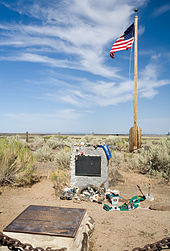Jean Baptiste Charbonneau
Jean Baptiste Charbonneau (born February 11, 1805 near Fort Mandan (now North Dakota), † May 16, 1866 in Danner , Oregon ) was the son of the French-Canadian fur hunter Toussaint Charbonneau and the Indian Sacajawea belonging to the Northern Shoshone tribe . As a toddler, he accompanied his parents on the Lewis and Clark Expedition in 1805/06.
A picture of him and his mother can be found on the American one-dollar coin . This makes him the only child who has ever been shown on an American currency.
Life
Jean Baptiste Charbonneau was born when the Lewis and Clark Expedition visited the Hidatsa prior to departure from Fort Mandan . His father was hired as an interpreter. His mother was also supposed to accompany the expedition in order to establish contact with the Shosons, since she was originally a Shoshon who was captured by the Hidatsa when she was about ten years old, kept as a slave and sold to Charbonneau. The presence of the woman and the toddler on the expedition is considered to be an essential reason why the whites were peacefully welcomed by all the Indians on the way. Indians never took women or even children on war expeditions, so that Sacajawea and Jean Baptiste were seen as a sign of the harmlessness of the travelers.
William Clark , one of the expedition leaders, called him "Pomp" or "Pompy". Pompeys Pillar , a prominent rock on the Yellowstone River in Montana , is named after him.
A few years after the expedition ended, the family moved to St. Louis at Clark's invitation . Clark paid the young Jean-Baptiste Charbonneau school fees for the St. Louis Academy, which is now St. Louis University High School. He continued to take care of the boy's care and schooling when his parents moved up the Missouri again and adopted him and his sister Lizette, who presumably died of childhood, in 1813.
When Charbonneau was 18 years old, he met Prince Paul Wilhelm of Württemberg , a nephew of King Frederick I of Württemberg . The prince, who was taking part in a natural history expedition in America, invited Charbonneau to travel to Europe with him. He then lived there for six years and learned four European languages. He traveled all over Europe and even visited Africa.
In 1829 Charbonneau returned to North America, where he lived as a trapper in the Rocky Mountains and as a scout for the army. In 1846 he led the Mormon Battalion from New Mexico to San Diego , California . There he took over the office of head of administration of the San Luis Rey mission station . After a while, however, he was forced to resign. The reason for this are conflicts over how the situation of the Indian tribes living there could be improved.
Charbonneau then got carried away by the California gold rush and joined thousands of other "49ers" in Placer County . As far as is known, he was unsuccessful and worked in a hotel in Auburn in 1861 . In 1866, at the age of 61, he made his way from California to the new gold fields that had been discovered around Virginia City , Montana . He died en route (probably of bronchitis ) in the Jordan Valley near what is now Danner, Oregon. There is a tomb for Charbonneau there, believed to mark the actual place of his death.
In the 1920s, the lawyer and professor was Grace Hebert in the Wind River Reservation of the Shoshone in Wyoming build three memorial stones, the graves of Sacajawea and her alleged two sons Jean Baptiste Charbonneau and Bazil men mark. This goes back to the now refuted assumption that Sacajawea, who actually died in 1812, lived in the Wind River Reservation until 1884 and brought her children there. This is probably due to the confusion with a highly respected Schoschone woman.
Individual evidence
- ^ Diary entry February 11, 1805 of the Lewis and Clark Expedition. The Journals of the Lewis and Clark Expedition Online, University of Nebraska-Lincoln .
- ^ The Lewis and Clark Journey of Discovery: Jean Baptiste Charbonneau website of the Gateway Arch National Park Missouri (English).
- ↑ a b Natalie Shure: How the West was Wrong - The Mystery Of Sacagawea . Buzzfeed, Oct. 11, 2015
- ↑ Bonnie Butterfield: Sacagaweas Death with reference to adoption documents from August 11, 1813
| personal data | |
|---|---|
| SURNAME | Charbonneau, Jean Baptiste |
| ALTERNATIVE NAMES | Pomp (nickname); Pompy (nickname) |
| BRIEF DESCRIPTION | participated in the Lewis and Clark expedition as a toddler and is depicted on the Sacagawea dollar coin |
| DATE OF BIRTH | February 11, 1805 |
| PLACE OF BIRTH | Fort Mandan |
| DATE OF DEATH | May 16, 1866 |
| Place of death | Danner (Oregon) |

